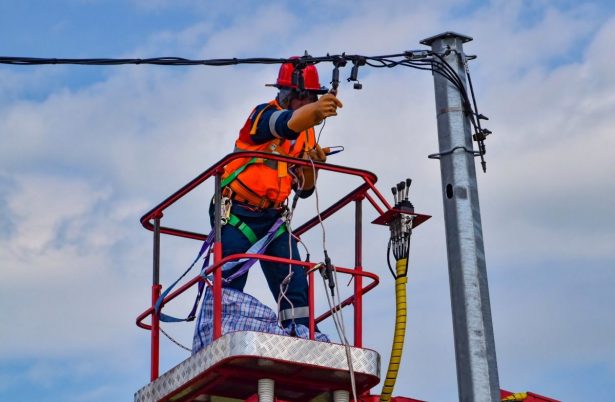The Google Nest is one of the best ways to start automating your home, usually one of the entry-level gadgets you get before going completely smart home enabled.
However, planning for a smart home is planning what to do when the power does go out, with each piece reacting differently. Today, we’re checking out how will the Nest Thermostat behave if power goes out.
The Google Nest will go into a power-saving mode when the power goes out, using an internal battery to power the system. If the battery runs out of power before power is restored, the system will completely shut down and require replacement batteries or be charged through the USB port.
Several things start to happen when your Nest does lose power and understanding each of these is important for its overall health.
We always recommend that people consider this whenever they are installing Nest thermostats throughout their homes. They are useful in keeping a wet basement dry, too, for example, but keeping temperatures under control.
What Happens If The Nest Loses Power?

The process the Nest goes through whenever there is a power interruption is rather simple to understand but can be surprising if you are unprepared. We always recommend that everyone fully understand what will happen and how to be fully prepared.
The Nest follows a basic set of instructions whenever the power does fail, as the system is ready to start up completely once power has been returned. It should be noted that Nest devices are meant to be used in countries where power is constant with little to no chance of weekly failure.
Testing To See If Power Is Available
When the power does go out, a switch is tripped, a fuse is blown, or you are moving the Nest, the first thing that happens is the Nest is looking for a power source. The screen may show a warning during this time to let you know that it is currently using battery power.
Further, the battery level will also be shown, helping you see how long the Nest can last without needing new batteries or reconnected. The Nest automatically detects whether or not there is power coming in from the wall, whether this is a dedicated line or as part of the home’s thermostat.
Going Into Standby Mode
Older Nests required that you turn the system off or force it to go into standby mode as they were not made to be used in areas with low-quality power.
However, new Nest systems will automatically go into a standby mode to preserve the power as much as possible.
In standby mode, the Nest uses the absolute minimum amount of power to ensure that everything is ready to start up again.
However, the system is not completely switched off and will use a small amount of power from the internal battery to be at the ready at all times.
Eventually Losing Power
Even in standby mode, the Nest will lose power after a few hours, with the internal lithium-ion batteries of the new Nests usually lasting longer. Older Nest devices use replaceable AAA batteries that will eventually run out and need to be replaced completely.
Many Nest devices will not work without a battery, which means that the battery needs to be charged to some degree for the Nest to work.
This is usually why people that have undergone several hours of power interruption need to wait just a bit longer to take control of the thermostat.

What Happens To The Nest When The Power Is Turned Back On?
Now that we know what happens as the power goes out, we need to take a look at the behavior of the Nest when the power goes back on.
There are currently three types of Nest devices, with older Nest devices known as the Google Nest, newer devices are known as the Nest E, and the Nest Thermostat.
These three devices all act differently when they regain power, and it is important to know how they will react to ensure the best possible use. We always recommend that people learn these basics of their Nest devices to have the best possible experience without becoming completely frustrated.
Now that things are solved, maybe you’re already dreaming about soaking the sun in the summer. Check out our complete UV index and tanning guide to make sure that you keep everything under control.
Charging Battery
All Nest devices from August 2017 have internal lithium-ion batteries included with the devices, which need to be charged.
This can either be done with the internal power connection or through an external USB port connected to a wall socket.
The Nest will generally take around one to two hours to fully charge and then continue operating as normal. However, if the battery is below a certain percentage, it will not work and stay in standby mode until it can fully start-up and start connecting to everything as needed.
Refusing To Start
Older Nest devices and Nest devices with completely flat batteries will usually refuse to start up when their batteries are completely depleted. For older Nest devices, all you will have to do is replace the AA or AAA batteries with fresh ones.
It should be noted that it will not take long for the thermostat to start up again, and all of them should be able to reconnect with your Wi-Fi as needed.
This had changed the most over the years as early Nest devices were completely inoperable when the batteries died, with no internal backup.
Waiting For Connection
Often, something can cause a problem because of routers being damaged or not fully started up after the power has dipped or shorted. The Nest will try to reconnect to the old Wi-Fi network that it was connected to before the power completely failed.
However, it should be noted that even if the Nest does not reconnect to the Wi-Fi, if it powers on, it can still control the thermostat completely as normal. You will have to go to the Nest devices directly to change the temperatures instead of doing it through a smartphone or tablet.
How Does A Nest Get Power?
Usually, the Nest gets power through the same wires that the old thermostat has received power, with most thermostats in the US and Canada having several wired connected. The Nest connects to these wires to control the thermostat as well as to receive power.
A few older thermostats do not have enough wires to properly power and connect to the Nests. For these thermostats, you will usually have to either rewire them or add in a new wire to provide the necessary power to the Google Nest.
Before you purchase your Nest, we always recommend that you check the current wiring of your thermostat to ensure that you can connect the Nest. We have heard many stories of people buying all the smart technology in the world only for their homes to be too outdated.
Conclusion
The Google Nest will continue to work just fine after the power has failed, but the rest of the heating system will usually not have power. This allows the Nest to instantly stay connected and ready should the power return to normal within a few minutes or hours.
Please always remember, these devices are smart, but they are not capable of powering air conditioners!

